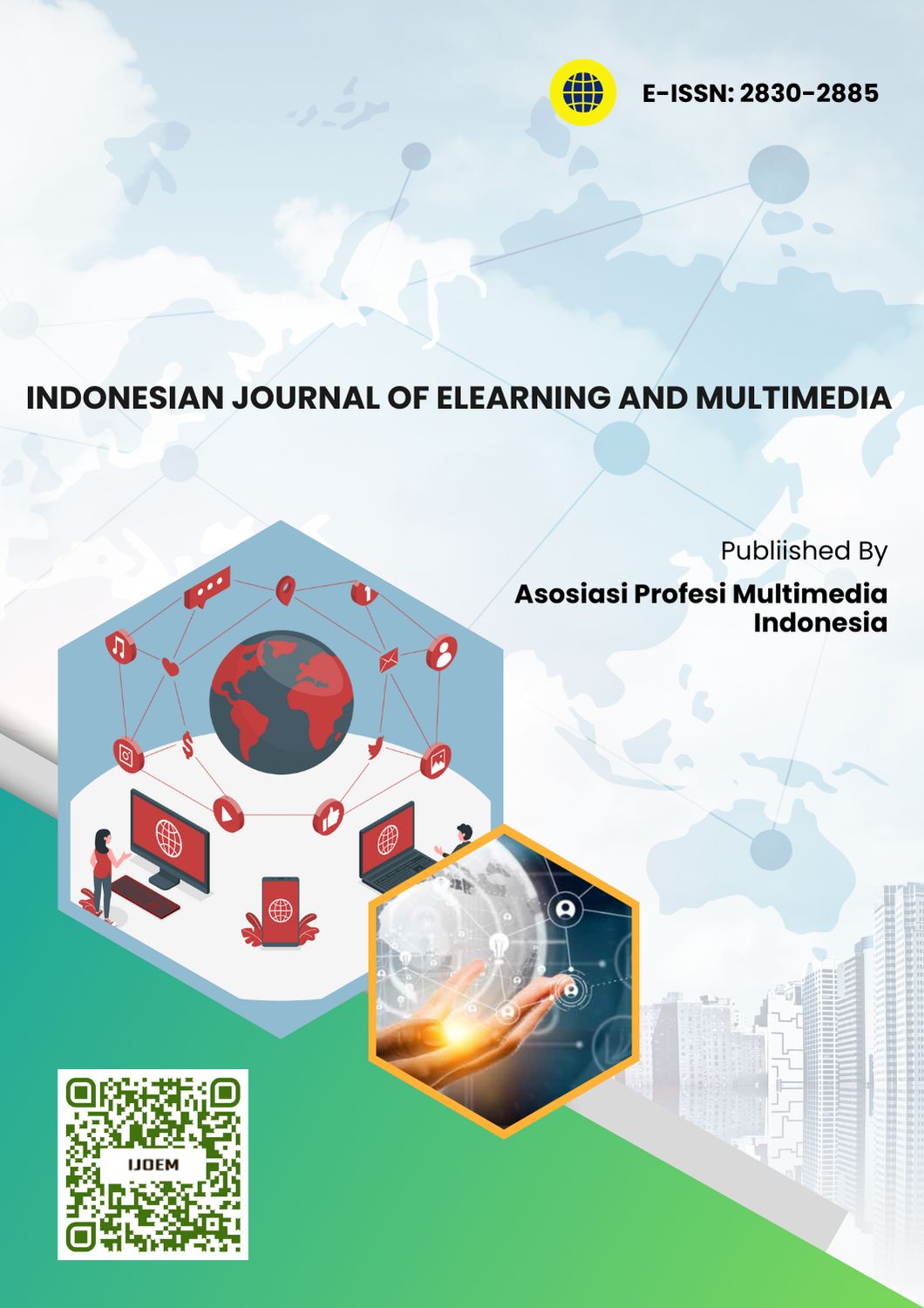Development of FAST (Fun and Smart Testing with Kahoot) Interactive Gamification Media to Improve Students' Understanding of Human Digestive System Materials in Grade V Elementary School
Main Article Content
Abstract
Background of study: Many elementary school students have difficulty understanding abstract science concepts, such as the human digestive system. Monotonous conventional learning methods are considered less able to attract students' attention.
Aims and scope of paper: This study aims to develop FAST (Fun and Smart Testing with Kahoot) interactive gamification media to improve students' understanding of the human digestive system material.
Methods: The research used the Borg & Gall development model synergized with the ADDIE model. The subjects of the study were 30 students in grade V of Ciherang State Elementary School, Sukabumi. Data collection techniques include observation, interviews, questionnaires, as well as pretest and posttest tests.
Results: The development and implementation of FAST interactive gamification media had a significant positive impact. Quantitatively, there was a substantial improvement in student learning outcomes; the average pre-test score of 47 rose to 91 in the post-test. An N-Gain analysis result of 0.82 indicated very high effectiveness in improving learning outcomes. The FAST media also underwent validation by learning design, media, and material experts, receiving very high feasibility scores: 94.4% (design experts), 96% (media experts), and 96.8% (material experts). Responses from both students and teachers were overwhelmingly positive. Students reported feeling more engaged, motivated, and enthusiastic. Teachers found the media helpful in explaining abstract concepts, facilitating direct learning evaluation, and creating a more lively classroom atmosphere, praising Kahoot! for its accessibility and flexibility.
Conclusion: FAST interactive gamification media is effective in increasing students' understanding and motivation to learn about human digestive system material.
Downloads
Article Details
Copyright (c) 2025 Deulis Ruswati, Endin Mujahidin, Rudi Hartono

This work is licensed under a Creative Commons Attribution-ShareAlike 4.0 International License.
References
Agbedahin, A. V. (2019). Sustainable development, Education for Sustainable Development, and the 2030 Agenda for Sustainable Development: Emergence, efficacy, eminence, and future. Sustainable Development, 27(4), 669–680. https://doi.org/10.1002/sd.1931
Akbar, A. N., Nurlina, & Magfirah, N. (2024). Penerapan Media Pembelajaran Berbasis Multimedia Interaktif Pada Materi Sistem Pencernaan Manusia Dalam Mata Pelajaran Ipa Kelas V Sdn 98 Bontomanai Bulukumba. Pendas : Jurnal Ilmiah Pendidikan Dasar, 09(2), 466–477. https://doi.org/10.23969/jp.v9i03.16678
Alenezi, M., Wardat, S., & Akour, M. (2023). The Need of Integrating Digital Education in Higher Education: Challenges and Opportunities. Sustainability (Switzerland), 15(6), 1–12. https://doi.org/10.3390/su15064782
Alsawaier, R. S. (2017). The Effect of Gamification on Motivation and Engagement. The International Journal of Information and Learning Technology, 35(2), 109–123. https://doi.org/10.1108/IJILT-02-2017-0009
Amirova, N. (2025). Traditional vs . Non-Traditional Teaching in Secondary Education : A Comparative Analysis. Porta Universorum, 1(3), 101–109. https://doi.org/10.69760/portuni.010309
Arkanudin, A., Ahmad, H. B., Qur, I. A.-, Raden, U. I. N., & Lampung, I. (2025). Challenges and Opportunities in Implementing the 21st Century Skills Learning Model for Fiqh Subjects. Al-Bustan: Jurnal Pendidikan Islam, 2(1), 58–80. https://doi.org/10.62448/ajpi.v1i2.92
Chans, G. M., & Castro, M. P. (2021). Gamification as a strategy to increase motivation and engagement in higher education chemistry students. Computers, 10(10), 1–24. https://doi.org/10.3390/computers10100132
Fauzan, F., Ansori, R. A. M., Dannur, M., Pratama, A., & Hairit, A. (2023). The Implementation of the Merdeka Curriculum (Independent Curriculum) in Strengthening Students’ Character in Indonesia. Aqlamuna: Journal of Educational Studies, 1(1), 136–155. https://doi.org/10.58223/aqlamuna.v1i1.237
Fauzi, M. H., Mutaqin, E. J., Rusmana, A., & I.Taofik, D. B. (2022). Pengaruh Media Pembelajaran Game Edukasi Terhadap. CaXra : Jurnal Pendidikan Sekolah Dasar, 2(2), 134–141. https://doi.org/10.31980/caxra.v2i2.853
Hasram, S., Nasir, M. K. M., Mohamad, M., Daud, M. Y., Abd Rahman, M. J., & Mohammad, W. M. R. W. (2021). The Effects of WordWall Online Games (WOW) on English Language Vocabulary Learning Among Year 5 Pupils. Theory and Practice in Language Studies, 11(9), 1059–1066. https://doi.org/10.17507/tpls.1109.11
Luo, Z. (2022). Gamification for educational purposes: What are the factors contributing to varied effectiveness? Education and Information Technologies, 27(1), 891–915. https://doi.org/10.1007/s10639-021-10642-9
Mazelin, N., Maniam, M., Jeyaraja, S. S. B., Ng, M. M., Xiaoqi, Z., & Jingjing, Z. (2022). Using Wordwall to Improve Students’ Engagement in ESL Classroom. International Journal of Asian Social Science, 12(8), 273–280. https://doi.org/10.55493/5007.v12i8.4558
Oliveira, W., Hamari, J., Shi, L., Toda, A. M., Rodrigues, L., Palomino, P. T., & Isotani, S. (2023). Tailored gamification in education: A literature review and future agenda. In Education and Information Technologies (Vol. 28, Issue 1). Springer US. https://doi.org/10.1007/s10639-022-11122-4
Osatuyi, B., Osatuyi, T., & De La Rosa, R. (2018). Systematic review of gamification research in is education: A multi-method approach. Communications of the Association for Information Systems, 42(1), 95–124. https://doi.org/10.17705/1CAIS.04205
Pitoyo, M. D., Sumardi, & Asib, A. (2020). Gamification-based assessment: The washback effect of quizizz on students’ learning in higher education. International Journal of Language Education, 4(1), 1–10. https://doi.org/10.26858/ijole.v4i2.8188
Puspitarini, Y. D., & Hanif, M. (2019). Using Learning Media to Increase Learning Motivation in Elementary School. Anatolian Journal of Education, 4(2), 53–60. https://doi.org/10.29333/aje.2019.426a
Putri, F. A., Islam, U., Sulthan, N., Saifuddin, T., & Belajar, M. (2025). Peningkatan Motivasi Belajar Siswa Melalui Penerapan Pendekatan Contextual Teaching and Learning pada Mata Pelajaran Ilmu Pengetahuan Alam dan Sosial Kelas IV Madrasah Ibtidaiyah Negeri 2 Bungo. Edu Society: Jurnal Pendidikan, Ilmu Sosial, Dan Pengabdian Kepada Masyarakat, 5(1), 1321–1328. https://doi.org/10.56832/edu.v5i1.1015
Resti, N., Ridwan, R., Palupy, R. T., & Riandi, R. (2024). Inovasi Media Pembelajaran Menggunakan AR (Augmented Reality) pada Materi Sistem Pencernaan. Biodik, 10(2), 238–248. https://doi.org/10.22437/biodik.v10i2.34022
Saleem, A. N., Noori, N. M., & Ozdamli, F. (2022). Gamification Applications in E-learning: A Literature Review. Technology, Knowledge and Learning, 27(1), 139–159. https://doi.org/10.1007/s10758-020-09487-x
Selviari, S., Rosidah, C., & Rosmiati, R. (2025). Peningkatan Hasil Belajar IPAS Materi Sistem Pencernaan Manusia melalui Penerapan Game Based Learning pada Siswa Kelas V SDN Dukuh Kupang 3 / 490 Surabaya. Dinamika Pembelajaran : Jurnal Pendidikan Dan Bahasa, 2(1), 2025. https://doi.org/10.62383/dilan.v2i1.1178
Uz Bilgin, C., & Gul, A. (2020). Investigating the Effectiveness of Gamification on Group Cohesion, Attitude, and Academic Achievement in Collaborative Learning Environments. TechTrends, 64(1), 124–136. https://doi.org/10.1007/s11528-019-00442-x



 Deulis Ruswati
Deulis Ruswati
